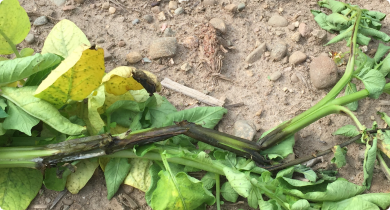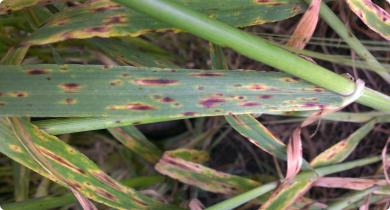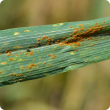Crop diseases
Plant diseases are a significant yield and quality constraint for growers of broadacre crops in Western Australia.
Plant pathogens can be fungal, bacterial, viral or nematodes and can damage plant parts above or below the ground. Identifying symptoms and knowing when and how to effectively control diseases is an ongoing challenge for WA growers of cereals (wheat, barley, oats and triticale), pulses (field pea, chickpea, faba bean), canola and lupin crops.
The Department of Primary Industries and Regional Development has a strong research, development and extension focus to assist industry to reduce the impact of crop diseases on all broadacre crops.
Results of extensive field/lab/glass house research and surveys across the WA grainbelt every year contribute to disease management packages and forecasting tools, and identify new incursions of crop pathogens or strains into WA.
The department also gathers and extends industry disease reports (PestFax), provides a disease diagnosis service and a broad range of management information for specific foliar and root diseases and viruses.
See Also
- Crop diseases: forecasts and management
- GRDC Research Updates 2017: Choosing the best yielding wheat and barley variety under high crown rot
- GRDC Research Updates 2017: UAV monitoring of rhizoctonia bare patch
- Research Updates 2017: Fungicides at seeding for management of cereal foliar diseases including spot type net blotch and wheat powdery mildew
- GRDC Research Updates 2017: Sclerotinia in canola - ground infections, effect of row spacing, plant density and fungicide. Is it worth spraying after you see the disease?
Articles
Filter by search
Filter by topic
- Grains (6) Apply Grains filter
- Wheat (6) Apply Wheat filter
- (-) Remove Mechanical, physical and cultural filter Mechanical, physical and cultural
- Crops (6) Apply Crops filter
- Control methods (6) Apply Control methods filter
- (-) Remove Grains research & development filter Grains research & development
- Fungi (5) Apply Fungi filter
- Chemicals (5) Apply Chemicals filter
- Fungicides (3) Apply Fungicides filter
- Pests (1) Apply Pests filter
- Pulses (1) Apply Pulses filter
- Viruses & virus-like (1) Apply Viruses & virus-like filter
- Oats (1) Apply Oats filter
- Nematodes (1) Apply Nematodes filter
- Barley (1) Apply Barley filter
- Canola (1) Apply Canola filter
- Lupins (1) Apply Lupins filter
- Bacteria (1) Apply Bacteria filter




